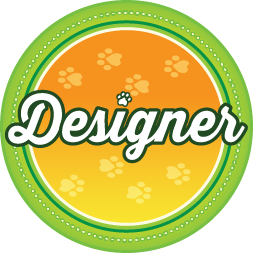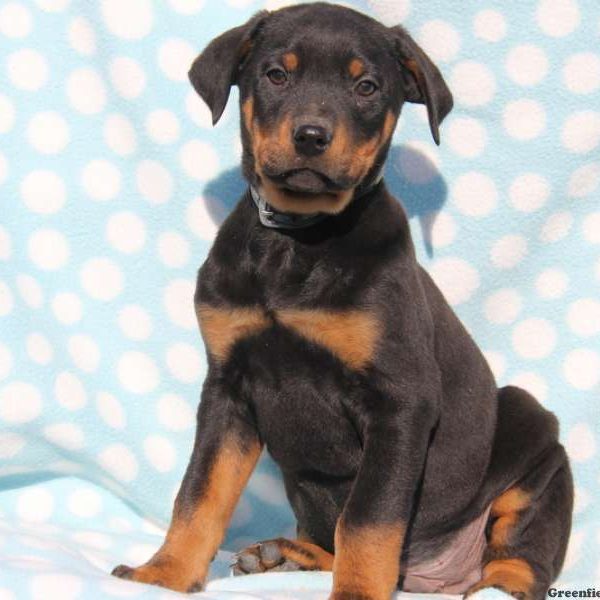
-
Activity Level:
high
-
Shedding Level:
low
-
Grooming Level:
low
-
Trainability:
high
-
Good for Novice Owners:
moderate
-
Adaptability:
moderate
-
Kid/Pet Friendly:
often
-
Prey Drive:
moderate
-
Watchdog:
very alert
- Average Size: Large
- Average Lifespan: 9-12 years
- Registered?: other
Rotterman Dog Breed Information
Overview
Temperament
Adaptability
Health
Owner Experience
Grooming
Activity Level
Size
Life Span
Did You Know?
The Rotterman is a cross between a Rottweiler and a Doberman Pinscher. These large, powerful dogs tend to be intelligent, energetic, and protective. They are known for being loyal dogs that are affectionate with their families.
Although the Rotterman is not currently recognized by the American Kennel Club, they are recognized by other notable dog organizations. The American Canine Hybrid Club, International Designer Canine Registry, and more all recognize the Rotterman.
Rottermans tend to have a gentle and sweet disposition. They thrive on attention and affection from their families and love being the center of attention at home. A Rotterman will also likely follow you around the house from time to time just to stay close. They tend to get along well with children and other pets that are part of the family unit.
They tend to be initially wary of strangers and will assess the situation, but will warm up once introduced. Rottermans do not tend to be aggressive dogs unless they are responding to a threat or have not been socialized properly. As with any dog breed, and particularly with protective breeds, proper socialization and training are important to raising a confident, well-balanced dog.
A Rotterman is a moderately adaptable dog breed. Because of their size and energy, they tend to be a better fit for homes with fenced-in yards where they can run freely. If you are willing to dedicate a large portion of every day to giving them the mental stimulation, exercise, and affection they need, they can do well in apartments.
They do relatively well in most climates. As with any dog breed, they are sensitive to heat. They do relatively well with some cold. But, you may need to stock up on some winter dog products to keep them warm while out on walks when temperatures get low. Although they can cope well with some alone time, these dogs do bond closely with you and prefer to be near you. As such, they should not be left alone for long periods of time.
Potential health concerns to be aware of in the Rotterman include hypothyroidism, eye issues, hip dysplasia, elbow dysplasia, Wobber syndrome, Von Willebrand’s disease, and heart issues. Reputable breeders will screen their dogs to avoid passing issues to puppies. So, make sure you ask about the health and genetic history of both of the parents.
As a large, barrel-chested dog breed, the Rotterman is at a higher risk of bloat. Bloat in dogs can become dangerous quickly if gastric torsion occurs. So, it’s important to know how to reduce the risk and know the symptoms so you know when to get immediate help for your dog.
Although these dogs are highly intelligent and pick up on things quickly, they also can be independent and stubborn. They require a more experienced owner who can train them consistently and confidently while using positive rewards and praise.
First-time dog owners can successfully train a Rotterman, but a professional trainer or obedience classes are highly recommended. Because they grow into large and powerful dogs that can have a dominant nature, it is essential to socialize and train them properly starting when they are young.
A Rotterman will have a short coat that sheds a little year-round. Weekly brushing and the occasional bath are all this dog’s coat needs to stay healthy and looking great. In addition to coat care, you will also need to care for your Rotterman’s nails, ears, and teeth.
Nail trims once or twice a month are usually enough to keep them from growing too long. You also want to check your dog’s ears on a weekly basis to make sure they are clean, dry, and free of any debris or pests. Doing this and carefully cleaning your dog’s ears as needed can help prevent ear infections.
Good dental care is often overlooked in dogs, which is why gum disease is one of the most common health issues. But, it doesn’t have to be one for your Rotterman. Brushing teeth every day or using an enzyme toothpaste daily along with cleanings at the vet as needed can help prevent painful dental diseases later in life.
The Rotterman is a high-energy dog breed that requires daily walks plus playtime and other activities to stay happy and healthy. They will also often be up for more activity if you are.
They are athletic and versatile dogs. So, once puppies finish growing and developing, you can try a variety of activities with them. Hiking, swimming, running, trips to the dog park, playing frisbee, training for dog sports, and more can all be great activities for this dog breed.
A fully-grown Rotterman usually stands 24-28 inches tall and weighs 70-130 pounds.
Rottermans generally live for 9-12 years on average.
Although they are most often called a Rotterman, they are also sometimes called a Rottie Dobie, Doberweiler, Doberott, Rottie Dobe, or a Rottweiler Doberman Mix.






